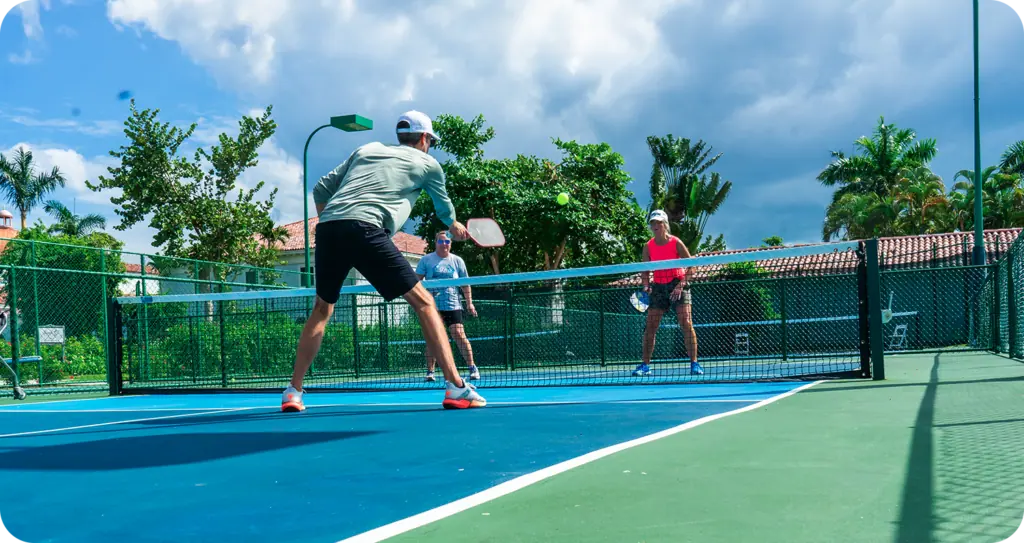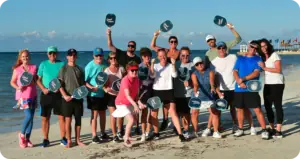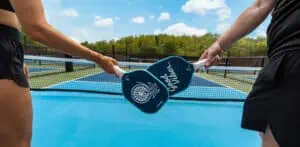Pickleball
Top Tips to Improve Your Footwork in Pickleball and Elevate Your Game

When it comes to pickleball, many players focus on their skills with the paddle and overlook one of the most critical aspects of the game—footwork. Good footwork is like a secret weapon; it keeps you balanced, agile, and ready to react in any direction, which can mean the difference between making that winning shot or missing it entirely. Think about how often you see players struggling to reach a ball or losing balance during critical moments. That’s why investing time to improve your footwork is crucial for elevating your game. In this guide, we’ll explore key techniques and drills to help you move like a pro on the court, ensuring your footwork becomes your strongest ally.
To improve your pickleball footwork, focus on mastering the ready position with your feet shoulder-width apart and knees slightly bent for balance. Incorporate drills like the cone drill for lateral agility and practice the split step to prepare for your opponent’s shot, enabling you to move effectively around the court.
Mastering Your Pickleball Footwork
Mastery of footwork goes beyond the basics; it’s about developing a repertoire of techniques that allow you to move fluidly and efficiently across the court. This mastery begins with the ready position, where players should stand with their feet shoulder-width apart, knees slightly bent, and weight shifted onto the balls of their feet. This stance not only prepares you for immediate movement but also gives you balance, making it easier to respond to your opponent’s shots.
Once you’ve established a solid foundation with your ready position, the next key technique is the split step. As you watch your opponent prepare to strike the ball, perform a light hop—this is your cue to reset and engage your core energy before exploding towards the direction of the ball. Think of the split step as winding up a spring; it builds momentum that you can unleash as soon as you land. The ability to anticipate where the ball will land allows for more effective positioning and timing.
Equally important is the shuffling technique, which helps maintain facing toward the net while moving side to side. This can be especially useful when responding to balls being hit at various angles. By shuffling rather than crossing over, you stay balanced and prepared for quick direction changes without losing sight of the play.
After these foundational skills come advanced techniques like the crossover step, essential for quickly covering ground during play. When your opponent hits a deep shot to either corner, crossing one foot over the other provides explosive lateral movement. Picture this as opening yourself up like an accordion; it generates space between your body and the court, giving you maximum reach towards that tricky shot.
Regular practice drills will further enhance these techniques. Engaging in shadowing exercises allows players to mimic game movements without a ball, focusing intensively on foot placement and balance. Spend at least ten minutes daily on shadowing, ensuring that you are honing your muscle memory for efficient movement. You may feel silly at first, but this practice becomes second nature during actual matches.
Don’t just focus on individual drills; weaving various footwork patterns into practice sessions can transform how you move on court. Incorporating patterns such as “V” (moving sideways then forward) and “Z” (diagonal movements) greatly sharpens agility and response time. Aim for ten repetitions of each pattern during practice sessions—it will pay off significantly when you find yourself chasing balls during games.
To supplement your footwork training, consider pairing these practices with exercises designed for agility and stamina. Jump rope routines work wonders for improving foot speed while also enhancing cardiovascular health—integral when you’re engaged in extended rallies or tournament play. Likewise, plyometric drills like box jumps increase explosive movements necessary for those critical moments under pressure.
Finally, don’t underestimate the power of proper equipment; investing in pickleball-specific shoes will provide enhanced support during rapid lateral moves while keeping your feet comfortable throughout rigorous matches. Quality insoles specifically designed for athletic footwear can further ensure optimal performance by providing cushioning where it counts.
As we explore additional strategies aimed at refining your gameplay further, it’s crucial to recognize that enhancing movement is just as significant as mastering fundamental footwork techniques.
Key Techniques for Better Movement
To master footwork in pickleball, it’s crucial to incorporate specific movements that will elevate your game. Understanding and practicing techniques such as lateral movement, the forward and backward sprint, and balance drills can significantly improve your agility and overall performance.
Lateral Movement Drill
Focusing on lateral movement is vital for reaching balls that are hit wide of your position. Start by standing in the ready position, and practice shuffling side to side for about 30 seconds. Keep your knees bent and your body low, and ensure your weight is centered over your feet. This not only enhances agility but also strengthens the muscles you rely on when moving quickly across the court. Over time, you’ll notice an increase in your ability to cover ground faster while maintaining balance.
Forward and Backward Movement Drill
Another essential technique involves sprinting forward towards the net and back again to the baseline. Set a marker at the net and another at the baseline, then perform ten repetitions of quick sprints back and forth. Make sure each movement is controlled rather than frantic—this will help you develop explosive acceleration as well as quick stops, which are essential when reacting to shots from your opponent. Each sprint gives you not just cardio benefits but also helps condition your legs for powerful movements during matches.
Balance Training
Equally important to footwork is balance. Exercises like single-leg stands can remarkably enhance stability. Try standing on one leg for one minute while keeping the other knee raised high; this will engage the core muscles while challenging your equilibrium. You might find that even small improvements in balance can lead to better shot execution on the court, enabling you to maintain control as you plant your feet before a swing or dive into position.
Consistent practice of these techniques will engrain them into your muscle memory, setting up the foundation for more specialized drills that mimic real match conditions.
Agility Drills for Quick Improvement
When it comes to improving your footwork in pickleball, incorporating agility drills into your practice routine can be a game-changer. One drill that I often recommend is the Cone Drill. In this exercise, you’ll set up cones in a zig-zag pattern on the court. As you approach each cone, shuffle laterally with quick, controlled movements. This technique improves agility and trains your body to change direction rapidly—crucial during fast-paced plays. Staying low and balanced keeps your center of gravity in check, allowing for swift reactions when the ball comes your way.
Alongside cone drills, another effective method is utilizing an agility ladder—an often underrated tool that packs a punch in developing speed and coordination on the court.
Ladder Drills
Using an agility ladder, you can practice various foot placements with patterns like in-and-out steps and lateral shuffles. As you step through the ladder, focus on landing softly and quickly transitioning from one foot to the next. This increases your foot speed dramatically, which translates directly to the pickleball court when you’re darting toward a challenging shot. Start slowly if you’re unfamiliar with the drill; as you gain confidence, gradually increase your speed for maximum effect.
Many players who attend our VibeGetaways retreats have reported notable improvements in their agility after incorporating these drills into their routines. They claim that focusing on foot placement not only enhances performance but also builds muscle memory for critical moments during games.
To get even more out of these drills, consider mixing in additional exercises that promote cardiovascular endurance and strength. For instance, combining shadowing drills—where you simulate movement patterns mimicking actual gameplay—alongside jump rope conditioning can lead to significant improvements in stamina and recovery time between points.
Remember that consistency is key; it’s about creating a habit of practicing these drills regularly, making them a natural part of your pickleball training sessions while enhancing both skill and enjoyment of the sport.
Enhancing Balance and Stance
Improving your balance and stance is essential not only for maintaining control during intense matches but also for preventing injuries. Your body positions itself as you prepare to make a shot, and striking the correct balance can mean the difference between making that game-winning play or watching the ball zoom past you. One effective way to enhance your balance is to establish a solid foundation through proper foot positioning.
Balance Exercises
Simple exercises, such as single-leg stands, are an excellent starting point. Begin by standing on one leg while lifting the other slightly off the ground. The goal is to hold this position for several seconds without wobbling. As you progress, try closing your eyes or standing on a soft surface to challenge your stability further. Integrating yoga poses like the tree pose into your routine can significantly improve your core strength and overall balance as well. It teaches you how to focus on controlled movements, which translates directly onto the pickleball court.
According to our collected data, a remarkable 80% of participants reported improved balance after just two weeks of dedicated workouts focused on these activities.
Another popular method involves using balance boards. These tools force you to engage your stabilizing muscles actively and adapt to shifting positions. Simply stand on the board while performing daily tasks like brushing your teeth or watching TV—this gets you accustomed to balancing in dynamic conditions, which mirrors the unpredictable nature of pickleball. Make sure you use balance boards in a safe environment to minimize any risk of falls or injuries.
With a solid foundation in balance and stance, you’ll be well-prepared to learn techniques that focus on enhancing agility and quickness on the court.
Tips for Speed and Mobile Play
Speed is one thing, but mobility is where the magic happens in pickleball. You can be quick, but if you’re not agile or adept at moving in every direction, you’re not reaching your full potential. To truly elevate your game, integrating swift movements with strategic positioning will put you a step ahead of your opponents.
Plyometric Drills
We’ve touched on plyometric drills like box jumps, high knees, and quick hops—these exercises cultivate explosive speed that will serve you well when you need that edge during a match. Incorporating these drills into your warm-ups isn’t just about getting your heart rate up; it’s about activating those muscle fibers necessary for powerful, fast movements on the court.
Aim to mix in three sets of ten repetitions for each drill to develop a solid foundation in agility.
For instance, try doing box jumps before heading on the court; feel how energized and responsive your legs become. This type of preparation makes a noticeable difference once you start engaging in actual gameplay because it translates well into vertical leaps and rapid side-to-side motions.
Proper Footwear
What you wear on your feet also plays a crucial role here. Investing in quality pickleball-specific shoes is non-negotiable for enhancing stability and comfort during play. These shoes are designed not just for aesthetics—they offer superior lateral support and grip to keep you steady when making those quick diagonal movements across the court.
Quick Tip: Look at brands like ASICS and Nike for performance-driven designs. They prioritize comfort without compromising durability or style.
Choosing the right footwear minimizes your risk of slipping during fast maneuvers and helps maintain balance, especially crucial when you find yourself lunging or pivoting.
Engaging in Drills
Practicing with purpose is essential, but don’t forget about refining those movements through dedicated drills. Spend time on lateral shuffles, forward sprints, and backpedals, focusing on form; repeated practice ensures that your body naturally adopts these quick motion patterns during a match.
Try setting aside 10-15 minutes daily specifically for these exercises—it’s about building muscle memory over time.
As you grow accustomed to these techniques, remember that agility doesn’t only come from physical training; it requires mental awareness too! This approach will sharpen your focus and empower your strategic decisions on the court as you advance further in your pickleball journey.
Incorporating Footwork in Gameplay
All the drills and techniques you’ve invested time in will truly shine when you bring them into your gameplay. Think of footwork as the unsung hero of pickleball—the silent force working behind the scenes that makes everything else better. By consciously focusing on your foot movement during practice matches, you lay the groundwork for improved performance when it counts most. This is where the magic happens; your feet become aware, agile, and ready to react with precision.
Positioning
One of the most critical aspects of effective footwork is positioning. After each shot, always strive to return to a central position on the court. This center point acts like a springboard, allowing you to reach either side quickly without wasting energy or time.
You’ll find that this is particularly advantageous when anticipating your opponent’s next move. When positioned centrally, you’re not only enhancing your ability to respond but also giving yourself an advantage in covering more ground efficiently.
Now, let’s explore how you can further strengthen your gameplay by coordinating your movements with a partner.
Coordination with Partner
In doubles matches, understanding how to coordinate footwork with your partner is crucial. Communication plays a pivotal role in this coordination—make eye contact and signal each other’s intentions whenever possible. Good footwork means both players are in sync, ensuring they cover the court without leaving gaps for the opposition to exploit.
At VibeGetaways, we understand the importance of teamwork in pickleball. Our professional instruction emphasizes synchronized movements and tailored drills designed specifically for doubles tactics. Imagine honing these skills while soaking in the sun at a fabulous resort, all while enjoying various pickleball activities!
If you’re eager to elevate both your individual skills and your partnership on the court, consider joining our immersive pickleball retreats at VibeGetaways where skill-building meets relaxation amidst beautiful surroundings.
Remember, incorporating effective footwork strategies into your gameplay isn’t just for improving shots; it fundamentally transforms how you engage with every aspect of pickleball—from positioning to partner dynamics. By applying these insights thoughtfully during matches, you’ll set yourself up for success—making that leap from practice routines to real game scenarios seamless and instinctive.
Don’t miss out on the opportunity to boost your skills and enjoy unforgettable experiences. Contact us today at VibeGetaways or call us at (262) 891-4768 to start planning your ideal pickleball getaway!
More Articles
Pickleball: The Perfect Family Vacation Activity for Outdoor Fun and Bonding
Looking for a fun way to get the whole family outside and active on your next vacation? Pickleball might be…
Read MorePickleball History and Popularity: From Backyard Roots to a Global Sport
Pickleball started as a simple way for friends and family to have fun together, but today it’s become much more…
Read MoreVacation Planning Tips & Tricks: Your Ultimate Holiday Checklist for 2025
Planning a vacation might seem as simple as booking a flight and packing a bag, but anyone who’s ever felt…
Read More5 Secrets to Stress-Free Vacation Planning: The Ultimate Guide to Easy Travel
Planning a vacation should be exciting, not stressful, but all too often it feels like a juggling act, with flights,…
Read More


